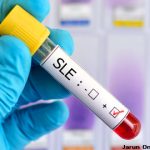‘SLE has long been a disease with many clinical manifestations but few treatment options,’ says Physician Editor Bharat Kumar, explaining why he thinks this article is a must-read. ‘That’s rapidly changing with advances in our knowledge of lupus, especially in the role of B cells in triggering the onset and perpetuating disease activity of lupus.’
“B cells are central orchestraters of autoimmune disease by contributing to autoantibody production, antigen presentation and cytokine production,” says Georg Schett, MD, head of the Department of Medicine 3 (Rheumatology and Immunology) of the Friedrich-Alexander University Erlangen-Nürnberg, Germany. “B cells can be inhibited by monoclonal antibodies and chimeric antigen receptor (CAR) expressing cells.”

Dr. Schett
Dr. Schett is the corresponding author of a review that is part of a series on immunology for rheumatologists launched earlier this year in Arthritis & Rheumatology (A&R).1 In this new installment, Dr. Schett and co-authors discuss the functional aspects of antibody- and cell-based B cell-depleting therapy in systemic lupus erythematosus (SLE).2
B Cell Insights
“Rheumatologists will benefit from this article by getting a summary of the role of B cells in autoimmune disease and the methods to inhibit them,” Dr. Schett explains.
 The generation of autoantibodies by B cells is fundamental in the pathogenesis of SLE, the authors write. After B cells differentiate in the bone marrow, they populate the spleen and lymph nodes, undergoing further maturation to become memory B cells, antibody-producing plasmablasts and plasma cells. Targeting B cells is essential in the treatment of such autoimmune diseases as SLE, in which B cell tolerance is disrupted, leading to the development of autoimmune B cells and autoantibodies.
The generation of autoantibodies by B cells is fundamental in the pathogenesis of SLE, the authors write. After B cells differentiate in the bone marrow, they populate the spleen and lymph nodes, undergoing further maturation to become memory B cells, antibody-producing plasmablasts and plasma cells. Targeting B cells is essential in the treatment of such autoimmune diseases as SLE, in which B cell tolerance is disrupted, leading to the development of autoimmune B cells and autoantibodies.
The authors introduce the review with a patient case study illustrating chimeric antigen receptor (CAR) T cell treatment for SLE. Next, the review examines the immunopathology of SLE, followed by a discussion of how B cells trigger physiologic and pathologic humoral immune responses. The authors discuss lessons from antibody-mediated therapeutic B cell targeting and deep B cell depletion via CD19 CAR-T cells in SLE, and cellular sources of antibody production by CAR-T cells. Lastly, the review returns to the patient case study, discussing the tolerability of B cell depletion in autoimmune disease.
The review includes detailed figures and legends, and many references.
Example Case
 The review describes a 32-year-old white woman diagnosed with SLE when she is 33 weeks pregnant. The patient presents with pericardial effusion, proteinuria, thrombocytopenia and anemia. Dysarthria and ataxia with isolated white matter lesions on magnetic resonance imaging suggest cerebral involvement. Serology is positive for anti-nuclear antibodies and highly positive for anti-double-stranded DNA antibodies and complement consumption. The SLE Activity Index is high. Initial treatment includes glucocorticoids and hydroxychloroquine.
The review describes a 32-year-old white woman diagnosed with SLE when she is 33 weeks pregnant. The patient presents with pericardial effusion, proteinuria, thrombocytopenia and anemia. Dysarthria and ataxia with isolated white matter lesions on magnetic resonance imaging suggest cerebral involvement. Serology is positive for anti-nuclear antibodies and highly positive for anti-double-stranded DNA antibodies and complement consumption. The SLE Activity Index is high. Initial treatment includes glucocorticoids and hydroxychloroquine.
After lupus nephritis is diagnosed via biopsy, the patient receives mofetil treatment, which is ineffective in achieving remission, as are tacrolimus, belimumab, cyclophosphamide and rituximab.
The review discusses the patient’s signs and symptoms, which indicate an active, treatment-refractory state. After the conduction of CD19 CAR-T cell treatment, which is described in detail, disease activity improves rapidly and the patient’s symptoms resolve. The principle and main outcomes of CAR-T cell treatment are demonstrated in a detailed figure.
“The example case illustrates the principal possibility to resolve SLE via a single infusion of therapeutic T cells that induce deep B cell depletion. This observation highlights the seminal role of B cells in mounting inflammation and tissue damage in SLE,” the authors write. “The elimination of disease-specific autoantibodies without induction of hypogammaglobulinemia or loss of vaccination responses points to the fact that at least some autoantibodies—those directed against DNA and nucleosomes—mostly stem from plasmablasts and not from long-lived bone marrow plasma cells.”
B Cell-Depleting Therapy
Plasmablasts may not represent the principal source of all types of autoantibodies. In SLE, the contribution of plasmablasts and short-lived and long-lived plasma cells in autoantibody production is unknown. Patients with SLE may require a tailored treatment approach targeting plasma cells, such as with daratumumab. This monoclonal antibody recognizes the CD38 surface molecule expressed on several B cell-differentiation stages, including plasma cells and activated T cells.
However, “including the plasma cell compartment in a treatment approach must be weighed against its risks, such as loss of immune memory and abrogation of vaccine responses as well as increased infection risk arising from hypogammaglobulinemia,” the authors write.
CAR-T cells are genetically engineered T cells that express a surface receptor called CAR, comprising domains for extracellular antigen-binding and intracellular T cell activation. CAR-T cells that target the B cell-specific receptor CD19 were designed to eradicate malignant B cells in B cell leukemia and lymphoma. Autoimmune B cells also express CD19, so are susceptible to eradication by CD19-targeted CAR-T cells.
In SLE, CAR-T cell-induced B cell depletion is short, lasting for around three to four months after infusion, and despite B cell reconstitution, not followed by disease recurrence—a complete contrast to cancer.
“CAR-T cells are exhausted or eliminated after CD19 CAR-T cell therapy in SLE because the recurring B cells do not show evidence for an immune escape like the downregulation of CD19 expression observed in cancer cells,” the authors write.
Safety
While generally well tolerated, patients undergoing B cell-depleting therapy may become unresponsive to humoral vaccinations or develop hypogammaglobulinemia with an increased risk of infection. However, the short time to B cell reconstitution after CD19 CAR-T cell therapy limits both the development of hypogammaglobulinemia and the time of insufficient vaccination responses.
“Another interesting aspect is the good tolerability of CAR-T cell therapy in the few patients with SLE studied so far,” the authors write. “T cell activation and the resulting cytokine release in conjunction with target-engaged CAR-T cells is substantially milder, resulting in better tolerability of the treatment.”
The authors explain that the efficacy of CAR-T cells depends on antigen engagement and T cell activation, leading to the destruction of target cells. However, high-level target engagement leads to intense CAR-T cell activation, resulting in cytokine release syndrome (CRS) and immune-related effector cell neurotoxicity syndrome (ICANS)—acute events commonly occurring in B cell malignancies.
In the example case, CRS and ICANS did not occur. The authors note that data from previously treated patients with SLE show no major CRS or ICANS, likely based on a lower target cell engagement of CAR-T cells, with fewer B cells in SLE than in B cell malignancies.
“The low-level acute toxicity of CAR-T cell treatment, such as CRS, and the possibility to be off further immunosuppressive drugs provides a new option for safe and long-term remission, especially in young women with SLE,” the authors conclude. At nine months after CAR-T cell administration, the case patient is “still in drug-free remission, being off glucocorticoids, hydroxychloroquine and all other immunosuppressive.”
Katie Robinson is a medical writer based in New York.
References
- Bucala R, Solomon DH. Immunology for the rheumatologist: A&R introduces a new problem-based immunology review series with great educational potential. Arthritis Rheumatol. 2024 Jan;76(1):9–10.
- Taubmann J, Müller F, Yalcin-Mutlu M, et al. CD19 chimeric antigen receptor T cell treatment: Unraveling the role of B cells in systemic lupus erythematosus. Arthritis Rheumatol. 2024 Apr;76(4):497–504.


